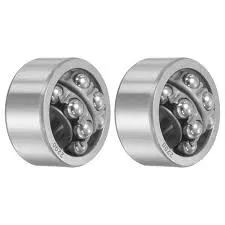
Dec . 20, 2024 18:57 Back to list
spherical roller bearing failure analysis
Analysis of Spherical Roller Bearing Failure
Spherical roller bearings are widely used in various industrial applications due to their ability to support heavy loads and accommodate misalignment. Despite their robust design and durability, these bearings can experience failures that significantly impact machinery performance and operational efficiency. Understanding the mechanisms of failure in spherical roller bearings is essential for effective maintenance and reliability improvements.
Common Causes of Failure
1. Wear and Tear Over time, friction between the rolling elements and raceways leads to wear. This wear can manifest as surface degradation, pitting, or spalling, significantly reducing the bearing's operational lifespan. Proper lubrication is crucial to minimize wear, as insufficient lubrication results in increased friction.
2. Contamination Contaminants such as dirt, dust, and moisture can infiltrate the bearing assembly, causing abrasive wear and potential failure. Contaminated lubricants can also exacerbate wear and lead to the formation of sludge. Regular maintenance, including the use of appropriate seals and filters, is vital in preventing contamination-related issues.
3. Misalignment Spherical roller bearings are designed to accommodate misalignment, but excessive misalignment can induce abnormal stresses and lead to premature failure. It can stem from improper installation, foundation settlement, or shaft deflection. Regular alignment checks and adjustments can help mitigate these issues.
4. Overloading Although spherical roller bearings can handle high radial loads, exceeding the bearing's load capacity can result in rapid fatigue and failure. Overloading may occur due to improper application selection or unforeseen operational conditions. It is crucial to monitor load conditions closely and choose bearings rated for the expected loads.
5. Fatigue Fatigue failure is one of the most common modes of bearing failure. It occurs due to repeated cycles of load application, leading to the formation of cracks within the material. These cracks can propagate, causing pieces of the bearing material to flake off, which ultimately results in a failure. Proper material selection and understanding the fatigue life can help in designing more reliable bearings.
Diagnosis of Failure
spherical roller bearing failure analysis

Effective diagnosis of bearing failure involves a systematic approach to assess the condition and root causes of the faults. Common diagnostic techniques include visual inspection, vibration analysis, and thermographic scanning. Visual inspection can reveal gross signs of wear or contaminants, while vibration analysis can detect abnormalities in bearing performance, such as imbalance or misalignment. Thermography can identify overheating issues, which is often indicative of lubrication problems or excessive friction.
Prevention Strategies
To mitigate the risks of spherical roller bearing failures, several strategies can be employed
- Regular Maintenance Establishing a robust maintenance schedule that includes regular inspections and lubrication checks is essential. This prevents conditions that can lead to premature failure. - Correct Installation Ensuring proper installation by adhering to manufacturer specifications is crucial. Misalignment during installation can lead to significant performance issues.
- Lubrication Management Selecting the right lubricant and maintaining adequate lubrication intervals can significantly enhance bearing life. It is also important to monitor lubricant quality to prevent contamination.
- Load Monitoring Implementing load monitoring systems can help ensure that bearings operate within their design limits, thereby preventing overload conditions.
Conclusion
Understanding the failure modes of spherical roller bearings is critical for enhancing machine reliability and performance. By addressing the common causes of failure through effective maintenance, proper lubrication, and monitoring, organizations can extend bearing life and reduce downtime. Employing a systematic approach to failure diagnosis and prevention strategies will ensure that equipment operates efficiently, ultimately resulting in cost savings and improved productivity in industrial operations.
Latest news
-
Premium Deep Groove Ball Bearings | High Speed & Reliability
NewsAug.29,2025
-
Durable Scaffolding Clamps - Secure & Reliable Tube Connectors
NewsAug.28,2025
-
Common Failures in Thrust Ball Bearings and Solutions
NewsAug.22,2025
-
How Tapered Roller Bearings Can Take Shock Loads
NewsAug.22,2025
-
Angular Bearings in High-Precision Spindles
NewsAug.22,2025
-
The Impact of Misalignment on Cylindrical Roller Bearing Performance
NewsAug.22,2025
